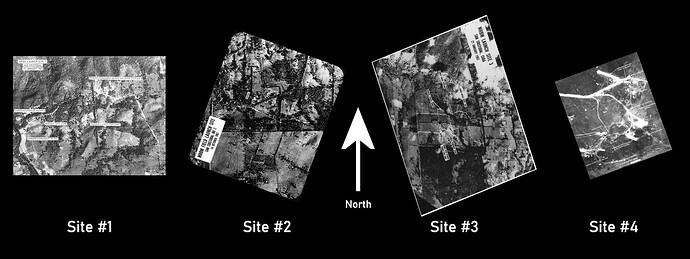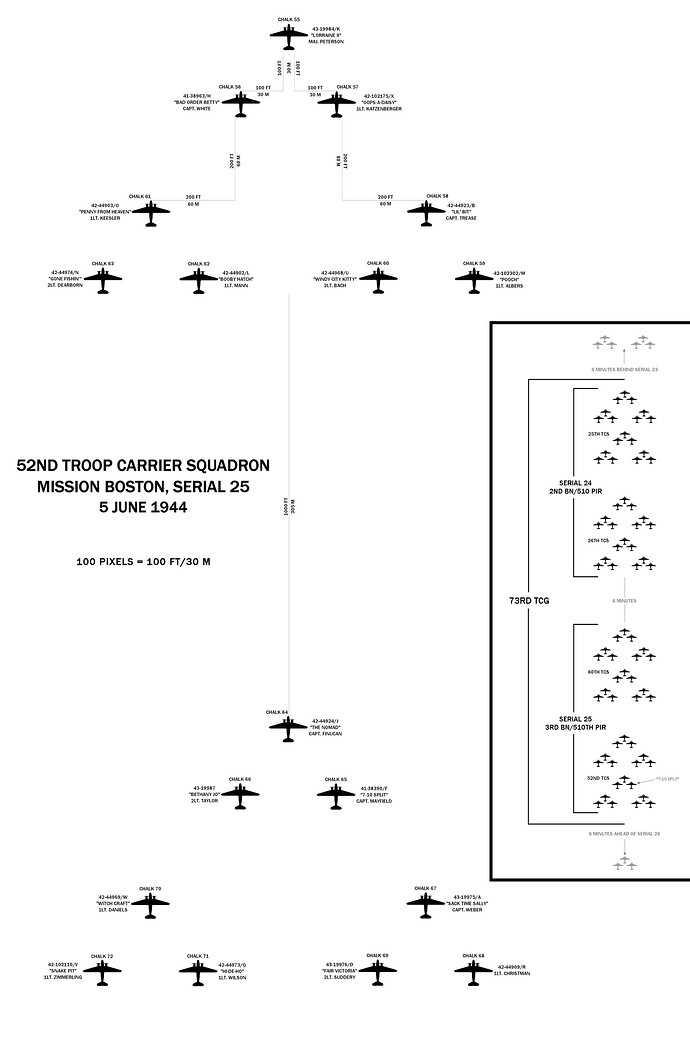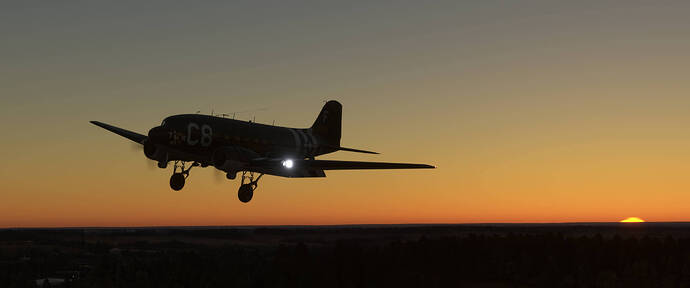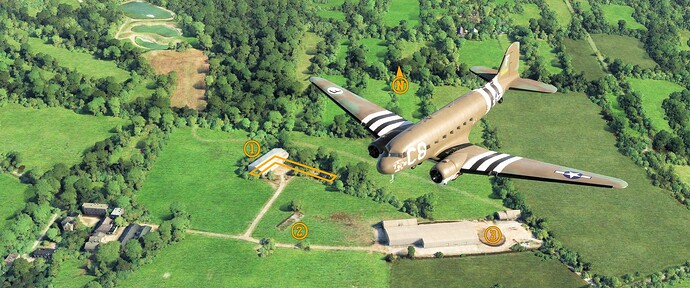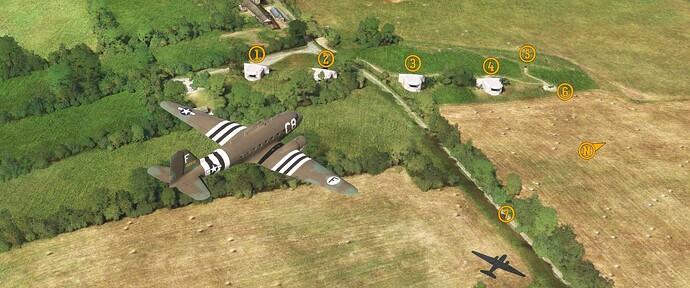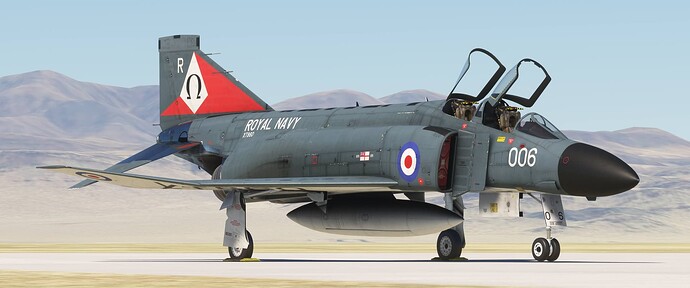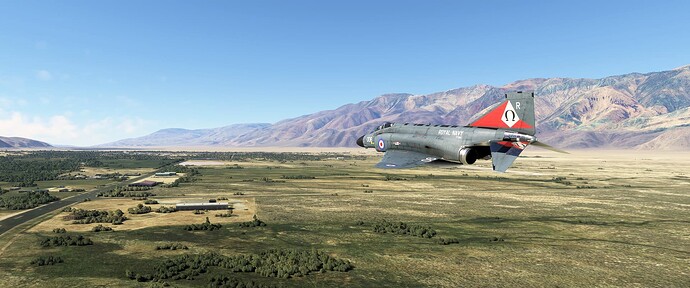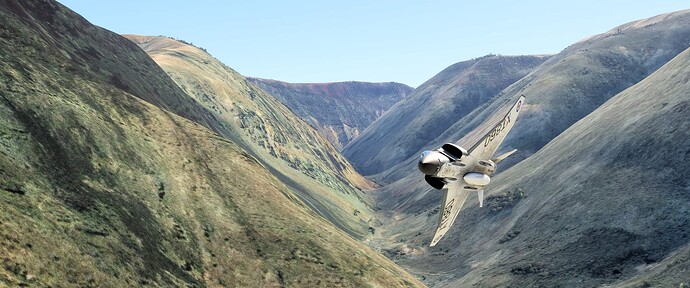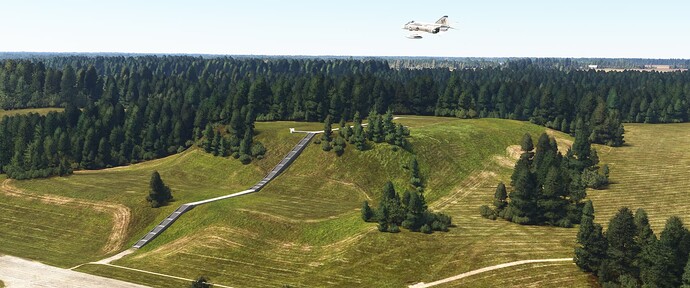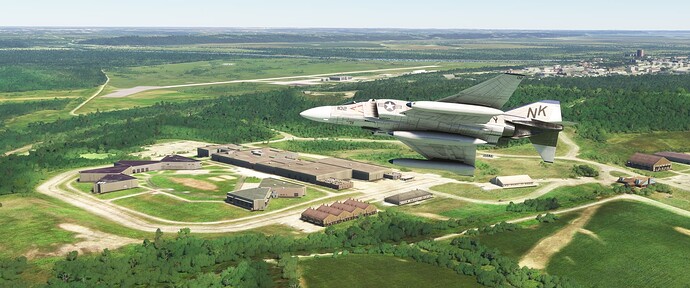Pee-Wee and Nag Over Middle America
St. Louis to Kansas City, Part One
Good evening, everyone! So, here’s the deal: every year, commercial airline pilots must undergo “recurrent training,” a mixture of classroom studying and discussion and simulator training and checking. I’m due in July. But thanks to the difficulties of scheduling pilots during the busy Summer travel months, my training has been delayed into my “grace month.” That means I won’t go to training until August, which means I can throttle back my studying for now, which means…
Pee-Wee says: Which means you can hang with me! Yay! 
Yup! Today we’ll be jetting around St. Louis before heading cross country to Kansas City.
Pee-Wee says: And we’ll be doing it in another Phantom. If you don’t get why we chose this aircraft…well, you’ll just have to wait and see. 
Here’s F-4J BuNo. 155587 in the markings of VF-143, one of the stock skins in DC Designs’s Phantom package. One of 522 J-model Phantoms built between 1966 and 1972, 5887 served with VF-143 at NAS Miramar until 1974 when the “Pukin’ Dogs” transitioned to the F-14 Tomcat. She subsequently passed to the “Aardvarks” of VF-114 and the “Pacemakers” of VF-121, then joined the Marine Corps and the “Lancers” of VMFA-212. Converted to an F-4S, 5887 joined VMFA-232’s “Red Devils” and was retired at MCAS Cherry Point in June 1986. Her ultimate fate is unknown.
Pee-Wee says: “Taproom 102” was the personal mount of VF-143 Executive Officer Commander Harley Hall and carried his name on the forward canopy rail. Sadly, Commander Hall became the last US Navy pilot lost over Vietnam only minutes before the negotiated ceasefire on 27 January 1973 when he and Radar Intercept Officer Lieutenant Commander Philip Kientzler were shot down by anti-aircraft artillery near Quang Tri in F-4J BuNo. 155768 “Taproom 113.” Commander Kientzler remained in Vietnam until being repatriated two months later, but Commander Hall was never recovered. Some of his remains were returned by the Vietnamese Government in 1993 but proved inconclusive as to his fate. Commander Hall was posthumously promoted to Captain and declared deceased in February 1980. His name is inscribed on the Vietnam Veterans Memorial, Panel 1W, Line 112.
VF-143’s 1972-73 cruise was the squadron’s second and last aboard CVN-65 Enterprise, and the last time the Pukin’ Dogs would see sustained combat until Operations Southern Watch, Enduring Freedom, and Iraqi Freedom almost thirty years later. The deployment was also the last time F-4s would regularly fly aboard Enterprise, their pride of place assumed by the F-14s of VF-1 and VF-2.
Well, shall we head out?
Pee-Wee says: We shall! 
 A Tale of Two Airports: Scott AFB / MidAmerica St. Louis Airport (KBLV)
A Tale of Two Airports: Scott AFB / MidAmerica St. Louis Airport (KBLV)
MSFS: 38.546 -89.837
Skyvector: 383248N0895014W
Scenery by projectzero3923 @ www.flightsim.to
We departed from Scott Air Force Base, home of the U.S. Air Force’s Air Mobility Command, n Belleville, Illinois, approximately seventeen miles east-southeast of St. Louis. Like a commercial airline’s dispatch center, operational control of all Air Force transport flights globally–from planning and scheduling to acquiring foreign overflight approval–is exercised by the officers and enlisted airmen stationed here.
The airport also serves as the civilian MidAmerica St. Louis International Airport (KBLV). Opened in 1997 this much maligned $313 million (€293 million) “Gateway to Nowhere” serves as a reliever for nearby St. Louis Lambert International Airport (KSTL), although after the collapse of the TWA/American fortress hub at STL, and even notwithstanding Southwest’s major operation there, it’s hard to see why Lambert requires a reliever. Ranked by passenger enplanements, STL is the 34th busiest airport in the United States, and on most days there’s more birds on the ramp than airplanes.
Pee-Wee says: Perhaps the identifier should be BND for “BooNDoggle?” 
Scott was opened during World War 1 as a pilot training field and named for Corporal Frank Scott, the first enlisted man killed in a U.S. aviation crash. Some 300 aviators trained here before the war’s end, when all flying activity ceased. Thanks to its centralized location, Scott was selected to become…
Pee-Wee says: Ooh! Let me! Scott was selected to become the center of the Army’s lighter-than-air (LTA) program.  Airship and balloon training was transferred here from California and Virginia, as was most depot material from Nebraska, and a new 850-foot long (260-meter) airship hangar and 120-foot long (36-meter) balloon hangar were completed in 1923. Unfortunately, after a series of fatal crashes, the Army terminated its LTA program in 1937. Boo.
Airship and balloon training was transferred here from California and Virginia, as was most depot material from Nebraska, and a new 850-foot long (260-meter) airship hangar and 120-foot long (36-meter) balloon hangar were completed in 1923. Unfortunately, after a series of fatal crashes, the Army terminated its LTA program in 1937. Boo. 
Scott served primarily as a technical training facility into the 1950s when the Military Air Transport Service and the Air Force’s aeromedical evacuation community arrived.
Today, flying units based here include the 375th Air Mobility Wing (C-21, C-40, KC-135), the Air Force Reserve’s 932nd Airlift Wing (KC-135), and the Illinois Air National Guard’s 126th Air Refuelling Wing (KC-135). On the commercial side of the field, Allegiant Air operates commercial passenger flights to Las Vegas and vacation destinations in the Southeast. Boeing’s new factory, where the company will produce MQ-25 air-refueling drones for the U.S. Navy, will open later in 2024.
Pee-Wee says: We tookoff from Runway 32L on the military side of the field and circled back around for this overview screenshot, in which you can see: (1) the Scott AFB Heritage Air Park display, which includes a C-9 Nightingale, C-21 executive transport, C-130 Hercules, KC-135 Stratotanker, C-140 Jetstar, and C-141 Starlifter, (2) the 126th ARW’s facilities, (3) Taxiway G connecting the two sides of the airfield, (4) the 932nd AW’s facilities, (5) the commercial passenger terminal, (6) the site of Boeing’s new drone factory, (7) home of the USAF’s Band of Mid-America [shout out to some fellow musicians  ], and (8) former location of the 1923 airship hangar, in the grass between the current ramp the the closed portion of Taxiway F. Hidden in the trees at the corner of Heritage and Symington Drives is (9) Building 7, formerly an electrical power station and storage building, now home of the Area Defense Counsel. Built in 1923, Building 7 is the oldest structure on the base, and was listed as a historical landmark by the St. Clair County Historical Society in 2010.
], and (8) former location of the 1923 airship hangar, in the grass between the current ramp the the closed portion of Taxiway F. Hidden in the trees at the corner of Heritage and Symington Drives is (9) Building 7, formerly an electrical power station and storage building, now home of the Area Defense Counsel. Built in 1923, Building 7 is the oldest structure on the base, and was listed as a historical landmark by the St. Clair County Historical Society in 2010.
From here we headed west toward our first stop, a site that makes that old power station look brand new!
 UNESCO Wonder: Cahokia Mounds State Historic Site
UNESCO Wonder: Cahokia Mounds State Historic Site
MSFS: 38.660 -90.062
Skyvector: 383938N0900344W
Scenery included with World Update 10
Pee-Wee says: Oftentimes I look at Asobo’s choices for Points of Interest and scratch my head. Such was the case when Sim Update 10 dropped. With so many historic or interesting sites worldwide, Asobo’s modelers chose…the Cahokia Mounds State Historic Site, because…what the heck is that? Well, in actual fact, it’s an extremely interesting place to visit, so I’ll just be over here in the corner learning my lesson… 
This 2,200 acre (890 hectare) Native American historical site was once part of the most influential city of the Mississippians, a mound-building native civilization that occupied large swaths of what is now the central United States between 800 and 1600 CE. Nearly 40,000 people lived here, making it the largest city to have stood in North American until 1780 when it was eclipsed by up-and-coming Philadelphia. The city was named Cahokia after the native tribe found living here by French explorers in the 1600s.
In total, Cahokia contains 80 mounds. Researchers estimate that the Mississippians moved approximately 55 million cubic feet (1.6 million cubic meters) of soil to create their city.
Pee-Wee says: Stand back: I’m going to try math (not my strong suit). That amount of dirt would fill 622 Olympic-sized swimming pools. Said another way, if we placed that dirt atop a regulation Olympic football pitch like Wembley, we’d have a rectangular column of dirt 735 feet (224 meters) tall which is, no matter how you do the math, a lot of dirt. 

Here we are passing just south of 100-foot (30-meter) tall “Monks Mound,” Cahokia’s largest and most prominent mound, named for Catholic monks that lived here between 1809 and 1813. Monks Mound has slumped (think “squashed like an overly wet sandcastle”) considerably over time and today its base is approximately the size of the Great Pyramid of Giza. A large wooden building–likely a temple or prominent chief’s home–once stood atop the mound.
To the west, and unfortunately not included in the Asobo 3D model, were five “woodhenges,” circular collections of partially buried wooden poles arranged similarly to Stonehenge. Only the restored “Woodhenge III” stands today. These wooden calendars were calibrated to their surroundings and required periodic rebuilding as construction and settling changed the sizes and shapes of Cahokia’s mounds.
Pee-Wee says: “Sorry I missed your birthday. That new bathroom extension on Mound 62 threw off my calendar.” 
 From Mounds to Humps: Alton & Southern’s Gateway Yard
From Mounds to Humps: Alton & Southern’s Gateway Yard
MSFS: 38.592 -90.142
Skyvector: 383531N0900834W
Next we flew approximately six miles (10 kilometers) southwest to the Alton & Southern Railway’s massive Gateway Yard and the St. Louis Downtown Airport (KCPS). Founded by the Aluminum Company of East St. Louis (later ALCOA, the Aluminum Company of America), the Alton & Southern was once jointly owned by the Missouri Pacific and Chicago & Northwestern Railroads. Today, the A&S is wholly owned by the Union Pacific.
Gateway Yard was greatly expanded by the MP and C&NW in the 1960s with the addition of trackage and a hump. Today the A&S generates nearly 50 trains and sorts 3,500 cars (of which 2,100 are humped) at Gateway daily.
Pee-Wee says: As of 2023, the A&S operated an all-EMD fleet including fifteen SW1500s (#1501–1512, 1514–1516, and 1517), a single MP15DC (#1522), two former UP/MP GP38-2s (#2000 and 2001), and two former UP SD60s (#2204 and 2205). The railroad’s smart colors and emblem are a combination of the MP’s and C&NWs.
Pee-Wee says: Wake up, East St. Louis! In this screenshot you can see: (1) the iconic elevated tracks approaching Gateway’s western boundary, (2) the yard control tower, (3) the arrival tracks where inbound trains are disassembled in preparation for humping, (4) the hump and its control tower, (5) the “bowl” where humped cars are sorted and assembled into trains, (6) the engine shed, (7) the departure yard where assembled trains are lashed to road locomotives, (8) the Canadian Pacific Kansas City Roalroad’s “B” interchange yard, and (9) the diamond where the Norfolk Southern and A&S cross. In the distant right you can see St. Louis Downtown Airport, a USAAF basic training field operated by Parks Air College during World War 2 from where Air Mid-America Airlines once provided service to Chicago-Midway and Springfield with Convair 600 turboprops leased from Texas International.
 Sooooooo Tempting: The Gateway Arch and Downtown St. Louis
Sooooooo Tempting: The Gateway Arch and Downtown St. Louis
MSFS: 38.624590 -90.184982
Skyvector: 383729N0901106W
Gateway Arch scenery included with World Update World Update 10
We flew southwest from Gateway Yard before turning sharply north over the Mississippi River for a gratuitous photo opportunity with St. Louis’s most iconic site, the 630-foot (192-meter) tall Gateway Arch. Designed by renowned Finnish architect Eero Saarinen in 1947, the Arch opened in October 1965 on the site of St. Louis’s founding.
Pee-Wee says: Does that name sound familiar, avgeeks? Yes, Saarinen is the same architect who divinated the masterful TWA Flight Center at Kennedy Airport in New York and the beautiful main passenger terminal at Washington-Dulles Airport. Incidentally, he’s also the man who rescued Jørn Utzon’s rejected design for the Sydney Opera House from the wastebin.
Visitors can travel to the top of this stainless-steel monument aboard cleverly-designed elevators within the Arch’s steel structure, although the experience isn’t for the faint-hearted or claustrophobic.
Pee-Wee says: Or the tall. If you’ve over six feet like both of us, try to get an elevator to yourselves. Everyone else will thank you. 
Here we are flying northbound past the Arch. You can see (1) Busch Stadium, home of the St. Louis Cardinals baseball team since 2006, (2) the 12th Street Yard where the Union Pacific’s Jefferson City Subdivision meets the Terminal Railroad Association of St. Louis’s Merchants Subdivision, (3) the 29-story Thomas F. Eagleton United States Courthouse, the largest courthouse in the United States, (4) the Gateway Arch, (5) the Old St. Louis County Courthouse, site of the landmark Dred Scott hearing that nudged America closer to the brink of Civil War in 1846, (6) the Gateway Arch Museum, and (7) St. Louis Riverfront Cruises, from where visitors can sail aboard replica paddlewheel steamers.
 A Big Number 2 and the Briefs of the Gods: The City Museum
A Big Number 2 and the Briefs of the Gods: The City Museum
MSFS: 38.633584 -90.200664
Skyvector: 383801N0901202W
Pee-Wee says: Here we are passing low over Bob Cassilly’s eclectic and inspired City Museum at the corner of Lucas Avenue and 6th Street in St. Louis’s Washington Avenue Loft District. Cassilly, a native Missourian sculptor and entrepreneur with more than thirty-six local building renovations, construction projects, and even a restaurant to his name, purchased the abandoned 250,000 square foot (23,000 square meter) International Shoe warehouse in 1993 and began construction of this “all ages playground” immediately. The City Museum opened in October 1997, and with more than 420,000 visitors annually, it’s the fourth most popular attraction in St. Louis after the Zoo, Gateway Arch, and Botanical Garden.
You have to see this place to understand the scope of Cassilly’s vision. There’s a life-size Bowhead Whale sculpture in the entrance lobby, tunnels and a giant slinky that visitors can climb through, slides running between the museum’s floors including a ten-story behemoth that starts on the roof, a skateboard park, a circus, a functioning small-scale locomotive, the world’s largest pencil, an art gallery, a rooftop Ferris wheel, a gigantic pair of underwear, and a 19th Century log cabin in which Daniel Boone’s son once lived (more about that later).
Pee-Wee says: Speaking of underwear, only a few months ago the City Museum set a world record by hosting the largest group of people wearing underwear on their heads, an odd record previously held by Naperville, Illinois. Because, why not? 
Outside and atop the main building is a giant playground complete with climbing tunnels, a school bus perched precariously over the roof’s edge, and two Sabreliner 40 corporate jets, both of which are visible in the photo above (one pointing toward the camera with the second’s fuselage visible below and to the right).
Pee-Wee says: The more complete Sabreliner, the former N40BP, was built in 1965 and worked for several corporations before landing with Presant Industrial Supply Company in 1982. Sistership N225LS, also built in 1965, ended her flying days with the Medianews Group of Dover, Delaware.
Alas, MSFS’s photogrammetric representation of this fascinating place is somewhat lacking in detail. You can clearly makeout MonstroCity, the suspended outdoor play area, and the Sabreliners, but the rooftop details appear “melted,” including the metal preying mantis that sits stop the polished dome, the Ferris wheel, and the iconic dangling school bus.
 Junkyard of Dreams: Bissell Auto and Body Company
Junkyard of Dreams: Bissell Auto and Body Company
MSFS: 38.623628 -90.227355
Skyvector: 383725N0901339W
Pee-Wee says: Just over one mile (2.5 kilometers) southwest of the City Museum, nestled between a middle school, an equipment rental company, a driver testing center, and a food wholesaler is the Bissel Auto and Body Company, and behind the shop sits the finest collection of retired military aircraft on the south side of St. Louis (not much of a claim, I agree). Dan Bissell, the body shop’s founder and proprietor, purchased his first junkyard warbird, an F-105D, from a government auction at Davis-Monthan AFB in the early 1990s, and currently owns a unique collection spanning multiple generations, armed services, and even nationalities.
Pee-Wee labeled the aircraft in this northeast-facing screenshot. Click on the photo to enlarge it.
Pee-Wee says: Airframe history time! That’s F-105D 60-0452 down there. She entered U.S. Air Force service in 1961 and served in Europe with the 36th and 49th Tactical Fighter Wings before transferring to Nellis AFB and the 4520th Combat Crew Training Wing. Unlike so many of her sisters, 0452 never saw combat over Vietnam. She bounced around ANG units in Kansas, Georgia, and Virginia and picked up the name “Rebel Rider” before retiring to Davis-Monthan AFB in 1981.
The B-52G is reportedly 59-2564, one of seven 596th Bomb Squadron / 2nd Bomb Wing aircraft that participated in Operation Senior Surprise on 16 / 17 January 1991. “Doom 32” and her sisters flew to western Saudi Arabia directly from Barksdale AFB in Louisiana and launched thirty-one brand new AGM-62C cruise missiles at key targets in Iraq. The mission, covering 14,000 miles and lasting more than 35 hours, was the longest combat mission in history at that time, eclipsing even the RAF’s “Black Buck” missions during the 1982 Falklands / Malvinas War. Unfortunately 2564 survived only a few months longer, heading for Davis-Monthan and scrapping on 8 August 1991. Two other Senior Surprise aircraft survived and are currently on display: 58-0183 “Valkyrie” at the Pima Air and Space Museum in Tucson and 58-0185 “El Lobo II” at the U.S. Air Force Armament Museum at Eglin AFB, Florida.
 Things Are Looking Up: The James S. McDonnell Planetarium and Blue Angel #7
Things Are Looking Up: The James S. McDonnell Planetarium and Blue Angel #7
MSFS: 38.631245 -90.270885
Skyvector: 383753N0901615W
Here we are turning north around the James S. McDonnell Planetarium–part of the St. Louis Science Center–located on the southeastern edge of Forest Park next to the St. Louis Archery Club and the St. Louis Police Department’s horse stables. That’s Interstate 64 on the right, winding its way westward toward its terminus only a few miles west of St. Louis.
Nisei architect Gyo Obata designed this uniquely beautiful structure. Obata studied under Eliel Saarinen, father of Eeno Saarinen, and was the lead architect for the Dallas-Fort Worth International Airport in 1973. His most famous creation, though, is the Smithsonian’s National Air and Space Museum in Washington, D.C.
The photogrammetry here doesn’t look half bad, although it can’t resolve the iconic 33-foot (10-meter) tall alien statue Looking Up which stands in the circular grass median outside the planetarium.
Pee-Wee says: But you can see F/A-18B BuNo. 161746 hiding in the trees beyond the circular drive. Delivered in the early 1980s to VFA-122, the Navy’s West Coast F-18 Replacement Air Group (Fleet Replacement Wing for you NUBs), she spent her final active years as Blue Angel #7 before retiring to the National Naval Aviation Museum at NAS Pensacola in 2008. Two years later she was loaned to the St. Louis Science Center and proudly mounted outside the McDonnell Planetarium.
Incidentally, the James McDonnell for whom the planetarium is named is none other than “Mr. Mac,” the founder of the McDonnell Aircraft Corporation, which designed not only the Navy’s first carrier-based jet fighter, but also built the F-4 Phantom and F/A-18 Hornet right here in St. Louis.
Pee-Wee says: Oooooh. Full circle! 
 Sounds Like a Fun Time: Cementland
Sounds Like a Fun Time: Cementland
MSFS: 38.734 -90.215
Skyvector: 384405N0901257W
Pee-Wee says: No, this isn’t some marketing ploy by the concrete industry. Cementland was another barinchild of Bob Cassilly, founder of the City Museum. Cassilly purchased the abandoned Lafarge Cement Plant outside Riverview north of St. Louis with the intention of converting it into a massive outdoor art exhibit and playground complete with concrete sculptures, reimagined machinery, and even waterslides and a navigable river. He actively encouraged construction companies to dump their disused equipment and leftover bits and bobs here, quirky castoffs that became the paint on his canvas.
Unfortunately, Cassilly was killed in a freak bulldozer accident at the site in 2011. His family hoped to continue Cementland’s development, but instead sold the site at auction in 2022.
Pee-Wee says: Such a sad ending to a promising project. Based on photos I’ve seen, Cementland would have been a really neat place to visit, like the City Museum on steroids.
Here we are flying roughly north over Cementland. The photogrammetric representation in MSFS isn’t bad, although there’s far too many trees. Interestingly the smokestack that should stand directly ahead of our Phantom’s radome is missing. Many of Cassilly’s creations remain untouched here today, a silent tribute to a man who brought so much to the Gateway City.
 Birthplace of a Legend: The McDonnell Aircraft Company/Boeing St. Louis
Birthplace of a Legend: The McDonnell Aircraft Company/Boeing St. Louis
MSFS: 38.757660 -90.365626
Skyvector: 384528N0902156W
Pee-Wee says: So, Dear Readers, have you figured out why we chose the Phantom for this flight? If not, here’s a hint: almost every single Phantom was built at McDonnell’s factory in St. Louis.
 Uh…that wasn’t really a hint.
Uh…that wasn’t really a hint.
Pee-Wee says: If they haven’t figured it out by now, they clearly need to be told. 
McDonnell produced 5,057 F-4 Phantoms in twelve major variants at its St. Louis factory between 1960 and 1979. At the peak of production, 74 Phantoms rolled from McDonnell’s Building 42 on the northwest side of St. Louis Lambert Airport every month. Before the F-4, McDonnell built the FH Phantom, F2H Banshee, the F3H Demon, the F-101 Voodoo here, and the F-15 Eagle, AV-8 Harrier, and F/A-18 Hornet followed. Today the factory is partially abandoned, although the former flight test hangar is occupied by GoJets Airlines.
Pee-Wee says: Here we are flying northwest over the former McDonnell (now Boeing) facility at St. Louis Lambert Airport. I’ve marked: (1) the former flight test hangar where newly built aircraft were prepared for flight, (2) the factory building where aircraft sub-assemblies and equipment were built before heading across the railroad tracks to (3) the Building 42 “low bay,” where construction of individual airframes began. (4) Here’s the exit from Building 42’s final assembly “high bay” where the iconic McDonnell Aircraft sign was painted, and where many aircraft had their glamour shots taken. MSFS has this building wrong: the high bay should be twice as tall as the low bay. (5) Here’s the general and engineering offices and the (6) engineering annex. This (7) is the former Wabash Railroad mainline paralleling Banshee Avenue and (8) the threshold of Runway 24. These (9) hangars and (A) buildings are now part of Boeing’s flight test facility, and include (B) Building 101. We’ll talk about (C) in a moment.
The following paragraphs talk about a rather unpleasant airplane crash, so we’ve blurred them out. Click anywhere on the text to read on, or scroll ahead to the end. 
In 1966 McDonnell was producing Gemini spacecraft for NASA in Building 101. On 28 February, the Gemini 9 prime and backup crews–Elliott See and Charlie Basett, and Thomas Stafford and Eugene Cernan–flew T-38 Talons NASA 901 and 907 from Houston to St. Louis to undergo two weeks of simulator training here. See was leading in 901 with Stafford on his wing in 907. The weather at Lambert Field was marginal, with broken clouds under a 1,500-foot (457-meter) ceiling and visibility of 1.5 miles (2.5 kilometers) in light rain, snow, and fog.
Pee-Wee says: The official meteorological term for those conditions is “crummy.” 
When the formation broke out on the ILS to Runway 12, See assessed that they were too high and circled to the southeast. Stafford followed, but lost sight of See in the gloom and executed a missed approach. He and Cernan were radar vectored for another ILS approach. See continued to circle.
Pee-Wee says: A “circling” approach is little more than an instrument approach to the VFR traffic pattern. Once the pilot enters visual conditions and is close enough to the airfield, he or she may maneuver visually for landing. While not commonplace these days, it was quite common in the 60s.
Somewhere east of the field See caught sight of Runway 24 and turned to land, and that’s when things went wrong. Both engines were accelerating toward maximum thrust when NASA 901 struck the roof of Building 101 and crashed into a parking lot beyond. See and Bassett were killed instantly, and seventeen factory workers received minor injuries. There was no damage to the Gemini spacecraft under construction. The T-38’s approximate flightpath is marked at (C) in the screenshot above.
The NASA accident review board placed blame for the crash on See.
Pee-Wee says: See and Bassett were the second and third NASA astronauts killed in the line of duty.
Ted Freeman had died ejecting from his stricken T-38 while landing at Ellington AFB in Houston two years earlier. See’s and Bassett’s names are inscribed on the Space Mirror Memorial at the Kennedy Space Center in Florida. Stafford and Cernan became the Gemini 9 Prime Crew and launched successfully on 3 June 1966.
Pee-Wee says: Holy smokes! That was the longest short trip I’ve ever taken. 
Perhaps the Phantom wasn’t the optimal choice of aircraft for this trip. When our sites are less than two miles apart, flying at 450 knots isn’t really required!
Pee-Wee says: Wham! 4 G’s! Screenshot! Wham! 4 G’s! Screenshot! Ahhhhh! 
We landed at Lambert and took a break, then hit the skies again for the cross-country portion of this tour, which you’ll read about in Parts 2 and 3. We’ll need some more time to write those installments, so check back next week.
We hope you enjoyed this first part of our STL-MCI tour. I know we sure did!
Pee-Wee says: Thanks again for the kind and heartfelt responses, everyone. Knowing that people actually read and appreciate these tours is really encouraging. We’ll see you next week! 
![]()
![]()
![]() Let Slip the Dogs of War: San Julián Air Base
Let Slip the Dogs of War: San Julián Air Base![]() ) and anti-submarine aircraft. During the Missile Crisis, the Soviet Union deployed Ilyushin Il-28 (NATO: “Beagle”) of the 759th Mine and Torpedo Aviation Regiment here. The first of thirty-three aircraft arrived in crates from Bahia Honda on Cuba’s north coast around October 14th. Assembly of the jet-powered medium bombers began immediately and the first aircraft, an Il-28U (NATO: “Mascot”) trainer, flew on October 30th.
) and anti-submarine aircraft. During the Missile Crisis, the Soviet Union deployed Ilyushin Il-28 (NATO: “Beagle”) of the 759th Mine and Torpedo Aviation Regiment here. The first of thirty-three aircraft arrived in crates from Bahia Honda on Cuba’s north coast around October 14th. Assembly of the jet-powered medium bombers began immediately and the first aircraft, an Il-28U (NATO: “Mascot”) trainer, flew on October 30th.![]() The Rising Tide: La Coloma Air Base and S-75 Site
The Rising Tide: La Coloma Air Base and S-75 Site![]() The Tip of the Spear: The San Cristobal MRBM Sites
The Tip of the Spear: The San Cristobal MRBM Sites









